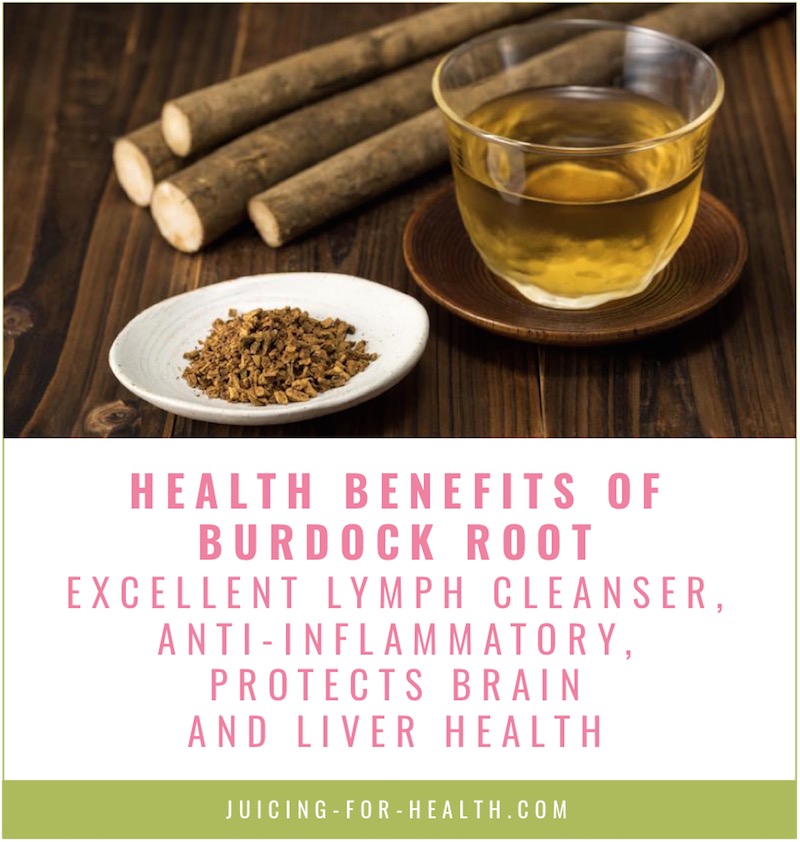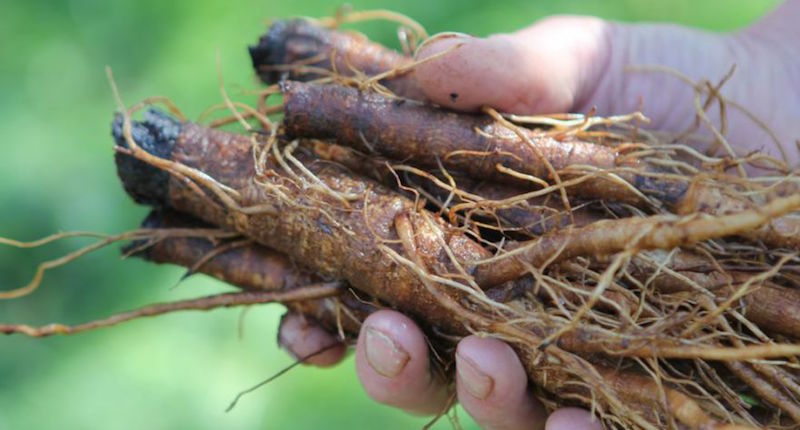Burdock Root Is An Excellent Lymph Cleanser, Protects Brain And Liver Health
Last updated on
Herbal action: alterative, anti-mutagenic, diuretic, diaphoretic, digestive stimulant, demulcent
Common name: Burdock, greater burdock, lappa, beggar’s buttons
Scientific name: Arctium lappa
Family name: Asteraceae
Parts used: roots, leaves, seeds, fruit

Phytonutrients In Burdock Root
- Inulin is a dietary fiber with powerful prebiotic properties. It can also improve insulin sensitivity and blood sugar levels, aid in weight loss, and reduce the risk of developing diabetes.
- Mucilage is a water-soluble dietary fiber that has a significant bulking effect: it expands in size after coming into contact with water or any other liquid, turning into a gel-like substance with soothing properties.
- Flavonoids (mainly quercetin) are natural antioxidants that can reduce inflammation and reduce cellular damage due to free radicals.
- Saponins are believed to help control blood cholesterol levels and combat diabetes.
- Lignans (mainly arctiin, arctigenin) are a class of polyphenols with scientifically-confirmed anti-inflammatory and antioxidant actions, along with dozens of other health benefits (some of them are described below).
Medicinal Uses And Burdock Root Benefits
Burdock root has many fabulous actions but its alterative properties are undoubtedly the strongest. This plant can strengthen the immune system (mainly thanks to the flavonoid quercetin), boost resistance to viral and bacterial infections, fight certain tumors and significantly reduce oxidative stress.
Burdock root has been traditionally used for centuries as a digestive stimulant, natural diuretic, and blood and lymph purifier.
Additional Health Benefits of Burdock Root, Leaves And Fruit
Anti-aging: Burdock leaf extract may contribute to skin care by inhibiting elastase (an enzyme that breaks down elastic fibers) when applied topically. This leads to a drastic improvement in skin elasticity and visibly reducing wrinkles.
Anti-inflammatory: Burdock root has prominent anti-inflammatory properties that are especially prominent in the liver, making this plant a fabulous liver protector. It effectively calms liver enzymes, reduces inflammation, and improves the liver function.
Mainly thanks to its antioxidant properties, burdock root preparations effectively alleviate inflammation and support the regeneration of inflamed tissues. For instance, several studies have confirmed this action in knee osteoarthritis and inflammatory bowel diseases.
Antitumor: Possibly due to its powerful antioxidant properties, burdock root shows significant antitumor properties by reducing proliferation and inhibiting metastasis in certain cancers. The most drastic effect has been confirmed on breast cancer and prostate cancer cells.
Antiviral properties: Laboratory studies indicate that arctiin and arctigenin, burdock’s main lignans, show significant antiviral properties against such viruses as the influenza one, once again confirming the fabulous alterative properties of this plant.
Aphrodisiac: Several animal studies have confirmed that water extracts of burdock root significantly improve sexual behavior by working both as an aphrodisiac (sex drive booster) and erectile enhancer. Also, burdock root extract increased testosterone levels in the same studies, making this plant especially promising for men.
Blood vessel functions: The inner lining of the blood vessels is known as the endothelium, and it has a number of important functions including nitric oxide (NO) synthesis and blood-clotting regulation. Burdock seeds are known to improve endothelium function, thus lowering risks of such cardiovascular diseases like arterial hypotension and atherosclerosis. The roots of this plant may have a similar effect thanks to their antioxidant properties.
Body weight and blood cholesterol: Thanks to its incredibly high content of dietary fibers, burdock root can help in losing weight and controlling blood cholesterol levels. Some other studies indicate that the inulin present in burdock root can help to reduce fat deposits in the liver and muscles. In general, this could help to reduce the risk of developing diabetes and all sorts of cardiovascular diseases including arterial plaque (atherosclerosis).
Gastro-protective and anti-ulcer effect: Chloroform extracts of burdock root significantly reduce gastric acid secretion, thus possibly improving symptoms of gastritis and help to heal peptic ulcers.
Lymph cleanser: Due to its diuretic and cleansing nature, burdock root is one of few herbs that can help stimulate lymphatic drainage. Drinking 3 to 4 cups of burdock root tea a day for one to two weeks, helps to remove congestions from the lymphatic system.
Neuro-protective: Arctigenin, one of burdock’s main lignans, has scientifically confirmed neuroprotective action in drug-induced memory impairment, Alzheimer’s disease, and alcohol-induced nerve damage, at least in animal studies.
Mild laxative effect: Inulin, a dietary fiber present in burdock root, has a mild bulking effect that could increase bowel movements, thus acting as a mild laxative. Mucilage, another type of fiber present in burdock root, has similar action.
Being a rich source of inulin, burdock root is likely to be a highly effective prebiotic, a substance that promotes the intestinal growth of beneficial bacteria.
How To Use Burdock Root
Burdock root is technically a root vegetable, so you may most likely find it in most Asian markets (occasionally at farmers market). Get it if you see it, it will change your life!
The easiest and most natural way to take burdock root is to eat it fresh, just like any other vegetable. In terms of taste, it can be described as somewhat resembling celery root—crunchy, mildly sweet, often called “earthy”. Since burdock root is a popular ingredient in eastern cuisines, finding a recipe to your taste won’t be hard at all!
Alternatively, you can just purchase a burdock root supplement which usually come in form of tinctures, powders, or capsules. Follow the instructions provided by the manufacturer for optimal effect.
You can use raw burdock root to prepare homemade decoctions:
- Take a clean saucepan and throw 2 tablespoons of burdock root into 2 cups of pure water.
- Bring to a boil, then lower the heat and simmer for about 10 minutes.
- Cool down the mixture and drink about half a cup 3 times per day.
Contraindications And Safety
- Burdock root is a well-known diuretic, thus not recommended to take in cases of dehydration.
- Hypersensitivity to any plants of the Asteraceae
- Safety of use during pregnancy and lactation has not been studied.
- Adverse interactions with conventional medications: none known. Take into account that burdock root somewhat increases bowel movements and thus could decrease the absorption of any other plants or drugs taken at the same time. It is recommended to take burdock root 2 hours before OR 2 hours after any other herbs or conventional medications.
As a rule, burdock root is tolerated incredibly well. No cases of overdose or toxicity are known. However, there have been rare cases of allergies and even anaphylactic shock. Therefore, burdock should be avoided (or taken with extreme caution) by those people who know they are sensitive to any plants of the Asteraceae family including:
- Chicory
- Sunflower
- Artichoke
- Chamomile
- Chrysanthemum
- Daisy
- Dandelion
Some of the links I post on this site are affiliate links. If you go through them to make a purchase, I will earn a small commission (at no additional cost to you). However, note that I’m recommending these products because of their quality and that I have good experience using them, not because of the commission to be made.
































 JOIN OVER
JOIN OVER
Comments